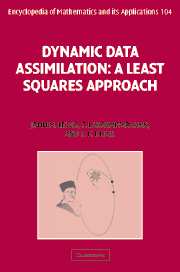Book contents
- Frontmatter
- Contents
- Preface
- Acknowledgements
- PART 1 GENESIS OF DATA ASSIMILATION
- PART II DATA ASSIMILATION: DETERMINISTIC/STATIC MODELS
- PART III COMPUTATIONAL TECHNIQUES
- PART IV STATISTICAL ESTIMATION
- PART V DATA ASSIMILATION: STOCHASTIC/STATIC MODELS
- PART VI DATA ASSIMILATION: DETERMINISTIC/DYNAMIC MODELS
- PART VII DATA ASSIMILATION: STOCHASTIC/DYNAMIC MODELS
- PART VIII PREDICTABILITY
- 31 Predictability: a stochastic view
- 32 Predictability: a deterministic view
- Epilogue
- References
- Index
31 - Predictability: a stochastic view
from PART VIII - PREDICTABILITY
Published online by Cambridge University Press: 18 December 2009
- Frontmatter
- Contents
- Preface
- Acknowledgements
- PART 1 GENESIS OF DATA ASSIMILATION
- PART II DATA ASSIMILATION: DETERMINISTIC/STATIC MODELS
- PART III COMPUTATIONAL TECHNIQUES
- PART IV STATISTICAL ESTIMATION
- PART V DATA ASSIMILATION: STOCHASTIC/STATIC MODELS
- PART VI DATA ASSIMILATION: DETERMINISTIC/DYNAMIC MODELS
- PART VII DATA ASSIMILATION: STOCHASTIC/DYNAMIC MODELS
- PART VIII PREDICTABILITY
- 31 Predictability: a stochastic view
- 32 Predictability: a deterministic view
- Epilogue
- References
- Index
Summary
In this and the following chapter we provide an overview of the basic methods for assessing predictability in dynamical systems. A stochastic approach to quantifying predictability is described in this chapter and the deterministic method which heavily relies on the ensemble approach is covered in Chapter 32. A classification of the predictability methods and various measures for assessing predictability are described in Section 31.1. Three basic methods – an analytical approach, approximate moment dynamics, and the Monte Carlo methods are described in Sections 31.2 through 31.4.
Predictability: an overview
Predictability has several dimensions. First, it relates to the ability to predict both the normal course of events as well as extreme or catastrophic events. Secondly, it also calls for assessing the goodness of the prediction where the goodness is often measured by the variance of the prediction.
Events to be predicted may be classified into three groups. Some events are perfectly predictable. Examples include lunar/solar eclipses, phases of the moon and their attendant impact on ocean tides, etc. While many events are not perfectly predictable, they can be predicted with relatively high accuracy in the sense that the variance of the prediction can be made small. Embedded in this idea is the notion of the classical signal to noise ratio. If this ratio is large, then the prediction is good. Examples include the prediction of maximum/minimum temperature in various cities of the world for tomorrow, prediction of tomorrow's interest rate for the 30 year home mortgage loan, prediction of the tax revenue by a state budget office for the last quarter of the current budget year, prediction of foreign exchange rate between U.S. dollar and Euro for tomorrow, etc.
- Type
- Chapter
- Information
- Dynamic Data AssimilationA Least Squares Approach, pp. 563 - 580Publisher: Cambridge University PressPrint publication year: 2006



